Right Ascension and Declinations
by Sergey Tarasov
While working with Declination, people often forget about the second part of the same story which is Right Ascension (RA). In this article I will explain the core of the problem using Zodiacs based on latitude. The usage of declination is very popular now. However, it is only one component of the astronomical coordinates. So it would be better to have a full astronomical picture and understand why and for what these coordinates are used. I will make a very brief introduction in astronomy and then consider the declination problem in more detail.
We start with considering our Solar System from different points of view.
Heliocentric Coordinates – outlook from the center of the Sun.
Imagine that we are in the center of the Sun. From there, we will see all the planets revolving around the Sun approximately on the same plane. Pay attention to the word “approximately”. In reality the planets’ trajectories are inclined to each other on several degrees. As the Earth’s inhabitants let us select one of these trajectories, the plane of the Earth’s trajectory which is called the Ecliptic.
The trajectories of other planets are inclined to the Ecliptic in some degrees; it is called heliocentric latitude. You can take heliocentric latitude as a measure of non-ideality of these trajectories. Thus, to get the full picture about some planetary position in heliocentric coordinates, we need to know helio longitude, helio latitude and the distance between that planet and the Sun.
Geocentric Coordinates – outlook from the center of the Earth
Let us imagine now that we are in the center of the Earth. Watching the sky we can select the path that the Sun forms during a year. This is the Ecliptic. The paths of other planets move close to the Ecliptic, though some inclination exists. It is called geocentric latitude and it shows how far the planets are from ideal Ecliptic path formed by the Sun and the Earth.
Thus we have another set of coordinates: geocentric longitude and latitude and the distance between the Earth and planets. In geocentric coordinates a new feature appears from planets moving retrograde.
Equatorial Coordinates – outlook from my home
Normally we watch the sky from some particular place on the Earth, not an imaginary one.. We can see the Ecliptic from there as the Sun’s path. Besides we can observe that stars and planets change their position within a day in respect to the horizon. This is because the Earth rotates making one full rotation every 24 hours. Only one star does not change its position during a day, this is Polar Star.
This fact allows to consider one more plane – Celestial Equator. This is the plane formed by daily rotation of the Earth around its own axis. It is inclined to Ecliptic at 23 deg 26 minutes. This angle changes very slowly.
So we have one more set of coordinates: right ascension – the angle of the planet in the Equator plane, and declination which shows how the planet is inclined to the Equator. Typically the planetary declination changes within 23 deg South – 23 deg. North.
Thus we have three main astronomical systems of longitude (it points the angular position) and latitude (it shows how much any planet is inclined to the main plain). Here they are:
System Longitude Latitude
Heliocentric Helio longitude Helio latitude
Geocentric Geo longitude Geo latitude
Equatorial Right ascension Declination
In this article I state that while working with declinations we should always keep in mind the right ascension coordinate as well. Otherwise we will not get the full picture of the planetary movement.
Let us start with the Sun. This is how the Sun’s declination changes during a year:
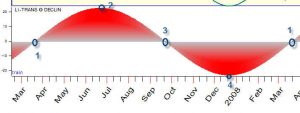
When the Sun ingresses Aries in the end of March, the Sun’s declination changes from South to North (point 1). At the end of June the Sun reaches maximum of North declination (this is Summer in North hemisphere, the longest day, the highest Sun). At the end of September the Sun’s declination changes from North to South and reaches the maximum of South declination in December. This is the full Annual cycle.
Now let’s consider the moments when the Sun ingresses cardinal signs in the right ascension Zodiac, together with the declination diagram:
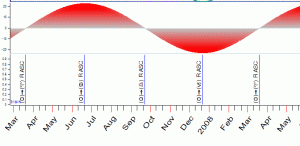
You see here that all the most important points on declination diagram (crossing zero and max North/South declination) correspond to the Sun’s ingresses to cardinal signs.
The Sun ingresses Aries in RA => declination changes from South to North;
the Sun ingresses Cancer in RA => declination reaches maximum North;
the Sun ingresses Libra in RA => declination changes from North to South
the Sun ingresses Capricorn in RA => declination reaches its maximum South
These facts are especially important when we consider other planets (as for the Sun there is not a big difference between RA and geocentric longitude).
Look at this diagram for Mercury declination together with Mercury’s ingress to cardinal signs in right ascension:
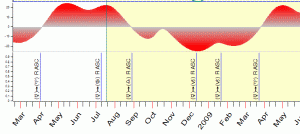
You see here some irregularity due to the retrograde Mercury’s movement, though in any case the ingress to cardinal signs of Zodiac indicates the most important moments of planetary trajectory. In any case, ingressing the first degree of Aries and Libra points exactly on zero declination case disregarding the retrograde or direct movements.
This is a diagram for Venus declination and its ingress to cardinal signs of Zodiac in RA:

This is the same diagram for Jupiter:
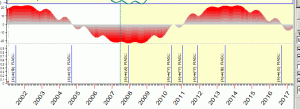
This irregularity (Jupiter ingresses Aries, and its declination is not zero):
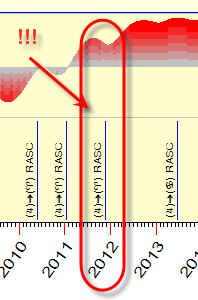
is caused by the fact that Jupiter ingresses (in RA) in retrograde motion from Taurus into 30th degree of Aries.
Therefore, to get a full picture of the planet in Equatorial coordinates, it is better to display two diagrams together: the declination diagram and the diagram of the planet’s ingress in right ascension Zodiac:

It is impossible to combine this information on one diagram or a special kind of Zodiac. It is as impossible as to draw 3D cube on a sheet of paper (2D). We can show only 2 2D projections instead.
Technically you can display this diagram as a combination of two events (the example is set for Venus):
1) Venus declination:

2) Venus’s ingress to the signs of Zodiac in right ascension:

Also I would like to mention the phenomenon of Out Of Bound (OOB). It is described here:http://www.timingsolution.com/TS/Articles/Dec/index.htm
Astronomically this phenomenon is described as a combination of two factors working together:
1) High declination due to the planetary position (it is around 0 degree of Cancer for North declination and 0 degree of Capricorn for South declination, see the diagram for the Sun’s declination):
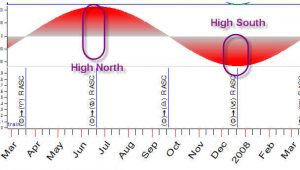
2) Plus North geocentric longitude of the planes is high. When these two factors work together, we have OOB effect:
North OOB – when the planet is located around 0 degree of Cancer and North geocentric latitude is high.
South OOB – when the planet is located around 0 degree of Capricorn and South geocentric latitude is high.
This is how North OOB phenomena looks for Venus:

I did this long astronomical explanation for education reasons only. Try to image how the planets move, and it will be easier for you to understand astrology. It seems to me that the old astrology masters have been in more preferred position than the modern ones. Old masters observed the sky, they have been astronomers as well because at their time there was no separation between these sciences. A modern astrologer gets the chart on the computer screen in an instant. It gives the wrong impression of easiness and simplicity, and we very often forget the reality that lies behind that chart. And this is a very dangerous game for astrology.